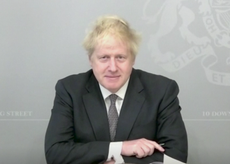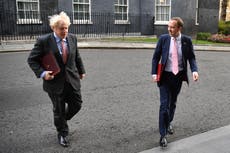Coronavirus: ‘Inadequate’ stockpiles forced Health Department to pay extra £10bn for PPE, report finds
Worldwide scramble for protective gear sent prices soaring by 1,000% or more
“Inadequate” stockpiles of personal protective equipment forced the government to pay £10bn over the odds for items such as face-masks, gowns and gloves in the first months of the coronavirus pandemic, a spending watchdog has found.
The worldwide scramble for PPE sent prices soaring by more than 1,000 per cent in some cases, and saw Matt Hancock’s Department for Health and Social Care spend £12.5bn on 32bn items which would have cost £2.5bn the year before, some of which turned out to be unfit for use, said the National Audit Office (NAO) in a report.
Meanwhile, the DHSC was accused of having “no plan” in place to secure vital medical equipment in an emergency, after a separate report found it lost a crucial month because it was “underprepared and reacted slowly” to the shortage of mechanical ventilators.
An inquiry by the House of Commons Public Account Committee (PAC) found the NHS in England did not even know how many ventilators it owned at the start of the outbreak, and that 26,000 were eventually bought for a total £569m, the majority of which have never been used.
The NAO found that many front-line health and care workers in England went without essential PPE between March and July, as the care sector received just 10 per cent and the NHS 80 per cent of their needs from government. Care homes were initially expected to source most of their PPE from private wholesalers and received just 331m items from DHSC in this period - 14 per cent of the total distributed - compared to 1.9bn going to NHS trusts.
Some 8,152 Covid-19 cases and 126 deaths were linked to occupational exposure among health and care workers, significant numbers of whom felt they were not adequately protected.
As demand for PPE rose in March, the government was initially reliant on PPE stockpiles designed for a flu outbreak which proved “inadequate” for a coronavirus pandemic, the NAO found.
In a “rapidly deteriorating” situation, the DHSC set up a parallel supply chain to speed distribution, but could “barely satisfy” requirements, with just 2.6bn items delivered to the frontline by July. It was not until the end of May that the system reported holding as much as one day’s worth of stock for all PPE items.
By July, some 32bn items of PPE had been ordered, but the global surge in demand led to “huge” increases in prices, from a 166 percent hike for respirator masks to 1,310 per cent for body bags.
“Had government been able to buy PPE at 2019 prices, expenditure on PPE to July 2020 would have been £2.5 billion - £10 billion less than it actually paid,” said the NAO. The extra cash spent equates to almost one-twelfth of the entire annual budget of NHS England.
Some PPE failed to meet required standards, with two orders totalling £214m for 75m respirator face masks which could not be used. Tens of millions of respirator masks ordered from other suppliers and some other types of PPE are also likely to be unusable for the original purpose.
PAC chair Meg Hillier said: “The pandemic caught the NHS on the wrong foot. The national stockpile was nowhere near big enough for a coronavirus outbreak – a consequence of the pandemic plans’ fixation on influenza.
“The government was far too slow to recognise how precarious the position was. When the penny finally dropped, DHSC had to scramble to buy what was left as prices went through the roof.
“The social care sector was largely left to fend for itself in the early months, while health workers couldn’t always get the PPE they needed. Shortages and confusing guidance added to the strain on front line workers.”
The head of the NAO Gareth Davies acknowledged that the authorities worked hard to source PPE “once they realised the gravity of the situation”, but said most arrived too late for the first wave of the disease. Government must learn “important lessons” about considering the needs of the care sector as well as the NHS, he said.
Meanwhile, the PAC report into ventilator procurement found that the government went into the pandemic with no plan in place to source additional critical care equipment in the event of an emergency.
NHS bosses did not put out a call to trusts to find out how many mechanical ventilators they had until late February - a month after the World Health Organisation declared Covid-19 a “public health emergency of international concern”.
The tally of 7,400 was far fewer than the 59,000 the NHS thought might be needed, sparking a race to buy more in March.
Estimates of the total number required increased rapidly to 90,000 by the end of March, before being sharply reduced to 6,200 in April. A DHSC target to acquire 30,000 ventilators by 30 June to prepare for a second wave was missed, with the figure eventually being hit on 3 August.
“It is fortunate that the majority of the ventilators were not needed and that additional capacity is now available should it be required,” said the PAC report. “However, the committee is concerned that the government’s targets were not effectively calibrated to need - and were not met.
“Even in the extreme circumstances of the emergency, there must be clear protocols in place to ensure that public money is protected, and that any exceptions or changes to procurement are justified. Despite having to operate at speed, DHSC still had a duty to carry out full due diligence for all parts of the supply chain, and it is not clear that the government’s checks were sufficient to provide that assurance.”
Ms Hillier said it was “much more by luck than design” that a ventilator was available for every patient needing one.
“DHSC incredibly had no plan for sourcing critical care equipment in an international emergency,” said the PAC chair. “It relied at first on an overseas market that was under great pressure and seeing prices increase exponentially because of the international nature of the pandemic.
“DHSC didn’t know what equipment hospitals already had, and its estimates of need fluctuated considerably as the pandemic progressed. Those targets that were set were universally missed.”
Eventual successes in the procurement operation cannot cover the fact that “much of it would have been unnecessary had DHSC and the NHS had a better plan for what to do to fill gaps in critical equipment in an emergency”, she said.
Health minister Jo Churchill said:“As the NAO report recognises, during this unprecedented pandemic all the NHS providers audited ‘were always able to get what they needed in time’ thanks to the herculean effort of government, NHS, armed forces, civil servants and industry who delivered around 5bn items of PPE to the frontline at record speed.
“We set up robust and resilient supply chains from scratch and expanded our distribution network from 226 NHS trusts to over 58,000 health and care settings.
“With almost 32bn items of PPE ordered, we are confident we can provide a continuous supply to our amazing frontline workers over the coming months and respond to future eventualities.”




Join our commenting forum
Join thought-provoking conversations, follow other Independent readers and see their replies
Comments